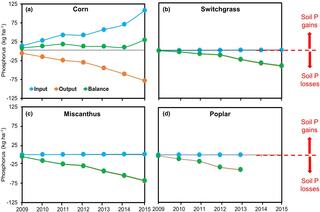Soil phosphorus drawdown by perennial bioenergy cropping systems in the Midwestern US
M.Z. Hussain et al. "Soil phosphorus drawdown by perennial bioenergy cropping systems in the Midwestern US" Global Change Biology - Bioenergy 15:254 (2023) [DOI:10.1111/gcbb.13020]
Without fertilization, harvest of perennial bioenergy cropping systems diminishes soil nutrient stocks, yet the time course of nutrient drawdown has not often been investigated. We analyzed phosphorus (P) inputs (fertilization and atmospheric deposition) and outputs (harvest and leaching losses) over 7 years in three representative biomass crops—switchgrass (Panicum virgatum L.), miscanthus (Miscanthus × giganteus) and hybrid poplar trees (Populus nigra × P. maximowiczii)—as well as in no-till corn (maize; Zea mays L.) for comparison, all planted on former cropland in SW Michigan, USA. Only corn received P fertilizer. Corn (grain and stover), switchgrass, and miscanthus were harvested annually, while poplar was harvested after 6 years. Soil test P (STP; Bray-1 method) was measured in the upper 25 cm of soil annually. Harvest P removal was calculated from tissue P concentration and harvest yield (or annual woody biomass accrual in poplar). Leaching was estimated as total dissolved P concentration in soil solutions sampled beneath the rooting depth (1.25 m), combined with hydrological modeling. Fertilization and harvest were by far the dominant P budget terms for corn, and harvest P removal dominated the P budgets in switchgrass, miscanthus, and poplar, while atmospheric deposition and leaching losses were comparatively insignificant. Because of significant P removal by harvest, the P balances of switchgrass, miscanthus, and poplar were negative and corresponded with decreasing STP, whereas P fertilization compensated for the harvest P removal in corn, resulting in a positive P balance. Results indicate that perennial crop harvest without P fertilization removed legacy P from soils, and continued harvest will soon draw P down to limiting levels, even in soils once heavily P-fertilized. Widespread cultivation of bioenergy crops may, therefore, alter P balances in agricultural landscapes, eventually requiring P fertilization, which could be supplied by P recovery from harvested biomass.
The data that support the findings of this study is available in Dryad https://doi.org/10.5061/dryad.dfn2z355r
